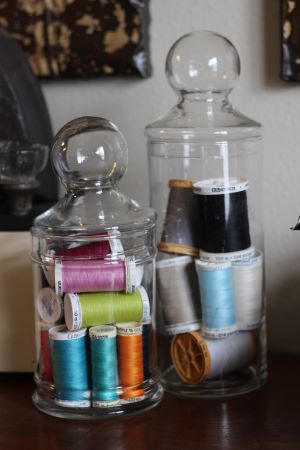Ironically, there are so many dangers in something as comforting as a sewing room. However, anyone who's ever "found" a lost pin with their bare feet can attest to the importance of sewing room safety.
Sewing room safety is something you should apply all the time, and you want to take special care if there's anyone else using the room as well, such as your spouse or kids. It's one thing to do a bit of damage to yourself, knowing that the injury was avoidable, but it can turn into a situation when your small child becomes injured.
With these safety tips, you can avoid a bit of guilt and pain!
Sewing notions can be a hazard to everyone if not taken care of properly. Children may try to eat or swallow grommets, buttons, and even bobbins. The best safety measure you can have for these small objects is to give everything a home. Preferably, that 'home' will be on a high shelf or in a locked cabinet and away from small children or pets.
Sewing room organization is a great way to ensure that you and your family remain safe.
When everything has a place, it makes your sewing more streamlined, and it also makes it easier to get into the habit of cleaning up. Any easy habit is more likely to stick, and when everything has a dedicated space, your cleanup time won't be spent trying to figure out where you can put things that your kids can't reach.
Another benefit of giving everything a dedicated area is that you'll know exactly what you're reaching into. Many crafters have been stuck by clothespins and needles that were in a thread box or fabric stash, but when you place everything back where it belongs, this is less likely to happen.

When handling sewing machines, it's easy to work with confidence. That confidence often makes people forget about apparent safety risks, such as sewing into your finger or smashing your finger in the presser foot — both unpleasant experiences.
When you're done sewing, pull the power plug out of the wall or disconnect it from the sewing machine. Modern sewing machines are straightforward to disconnect from a power source, and it's merely reinforcing the habit of practicing sewing room safety. If you have an industrial machine that is difficult to disconnect or is generally a challenge, consider instead, removing the needle from the machine and storing it appropriately.
Working with a sewing machine does involve some risk, so be sure you are using your sewing machine wisely and safely.
You can quickly use magnets to pick up lost or dropped pins to prevent any future accidents. You can also use magnets in place of pincushions.
Order magnets in bulk and scatter them throughout your storage areas so that you can quickly grab one whenever you need it. Otherwise, you run the risk of losing where you dropped your pin or needle while on the search for a magnet, only to find it later when you accidentally step on it.
Pin alternatives are possibly the best swaps you can make when sewing. Using clips instead of pins can eliminate the possibility of sticking yourself while feeding the fabric through a machine.
It also removes the possibility of spearing yourself in the foot after losing a pin in the carpet. Save yourself pain and strife, choose clips instead.
It should go without saying, but this is one step that is often left for a later date, and that is the cleanup. A clean room is always safer but keeping that room clean can be a real challenge.
At the end of your sewing session, do a sweep for a few items in particular. Remove any fabric scraps (they may have pins in them) and then pick up any potentially dangerous tools like rotary cutters.
Finally using one of your magnets do a quick sweep over the flooring and then you're ready to go! At GoldStar Tool, your safety is a priority, so be sure to keep your sewing room clean and make these safety habits become part of your routine.